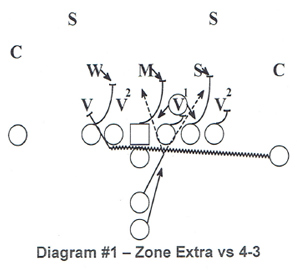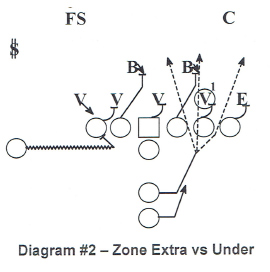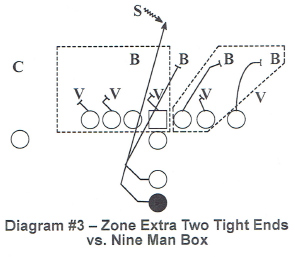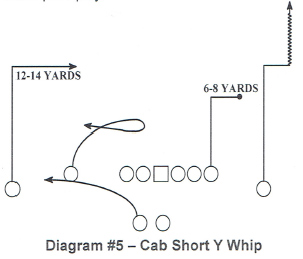| Understanding Red Zone Schemes on Offense
By: Jimbo Fisher - Florida State Univ. Originally Published in Nike 2014 Coach of the Year Clinics Clinic Football Manual - by Earl Browning
Thank You. The first thing I would like to say is it is an honor to be up here representing Florida State University. I have figured out how to get a room full of football coaches to sit inside and talk about football. All you have to do is to make it five degrees outside and you will draw a crowd. You could be doing a lot of things outside back in Florida at this time of the year. I love this part of the country with the hills and mountains. I grew up in West Virginia and I love the outdoors and I love hunting and fishing. I will tell you one thing though about this part of the country. I do not miss this weather, partner. I do not miss this a bit. When I go to a clinic I want to learn two or three things I can use in our program. The only way I have figured out how to do that is to ask questions. Everything I have learned, I have copied from someone else. I have developed my own philosophy on football, but I had to learn from someone else. The scary thing about clinics is coaches do not attend them much anymore. That is why it is so great that this room is full today. If you are going to learn and advance in a coaching career you have to learn from somebody. It changes so fast. If you learn one, two, or three things from what I talk about today, then I think it has been a very successful clinic. Asking questions is the only way you are going to learn. I figured out a long time ago I do not have all the answers. I also figured out a long time ago, good players win. If you do not have good players you can still win, but you end up practicing coaching a lot. I do not want to practice coaching, I want to practice winning. I believe there are three seasons in football. First you have recruiting. From January to August it is player development time. Finally you have the regular season. A team has a one-year life expectancy. People will say you have a great bunch of guys coming back, you should repeat as champions. I do not necessarily buy into that theory. You have four one-year life cycles for a four year letterman. In one given year, that same group of guys never-ever plays together again. Somebody is displaced from that group. As soon as that happens it becomes a totally different team. The Florida State University baseball team played the New York Yankees this year in spring training. I was asked to go down and throw out the first pitch because we won the National Championship. There was a large contingency of Florida State fans at the game. It was a great experience and I wanted to do it but more importantly, what I wanted to do was go pick the brains of the New York Yankees. Talk about a team with expectations. Talk about a team that deals with pressure and how to handle things. When you win a championship, how do you repeat winning a championship? I spent a lot of time with Joe Girardi and Brian Cashman. We talked about a lot of great things concerning training, player development, and the mental aspects of trying to repeat. Brian Cashman told me a story from 1996 when the Yankees won the World Series. They were a dominant team and one of the great teams of all time in terms of games won. In 1997 they had one player that was different from the 1996 team. They had most all of the same guys and leaders back, and you would think that would make it easier to repeat because they had the same chemistry. He said that year was one of the most dis-appointing years he had ever had. I asked him why? I am telling you this just like I told my staff and I tell everybody who has had some success. He said, "Because when you have success, everybody wants to be the reason for your success. Everybody in the organization wants a piece of that pie. As soon as you have success everybody wants attention. It becomes about me." Brian said it all started with the massage therapists. The players tipped their guy who they wanted to perform massage therapy on them, from their own pocket. One therapist did not get as much money from one player as another therapist did from another player. This is a massage therapist, guys. You might think every person in your organization is not important. The one guy did not get the money so he went directly to Brian Cashman, the General Manager of the New York Yankees. Brian explained to him the organization had nothing to do with it and it was not a bonus from the Yankees. It was the players perk to give, if they wanted to. This guy went on to complain to everybody in the organization and it eventually got back around to Brian Cashman. Think about that! This is the GM of the New York Yankees dealing with a massage therapist who was not feeling wanted. Eventually he had to fire the guy. Brian said what he learned from that experience as a young man was this? Everybody wants to feel important! I say this to you as coaches and I say this to anybody who has to deal with the infrastructure of an organization. Everybody that touches your players affects your kids, whether it is a teacher, classroom monitor, principle, or the booster club guy. Whoever wants to have a part of that pie, make sure they understand one thing? It is about the organization. No one in our organization including myself, the AD, the president of the university, no matter who they are, nobody has a job without those kids. It is not about us. It is about those kids. Remember they only have a short window to be good together and to play together as a team. You have to maximize that. I know as an assistant coach I had all of the answers. I knew everything. It is easy to say I wouldn't do it that way, or I would do it this way. When you get in the head coaches chair and you need to make that call and you turn around and there is nobody there, it is a little different. I have been around some great coaches. What I eventually learned was everybody in your organization has to feel important. I will use a Rolls Royce as an example. You can have the best interior, the best stereo, the best tires, and the best rims, but if one lug nut comes off, then what happens? The wheel can come lose and it can cause you to wreck. Everyone in your organization is critically important. You want to know why? It is because they can affect the attitude of your organization. You can work all the X's and O's you want, but if you do not recognize that, you will never be successful. It will eventually get back to the players. We have spent three times more time looking at what we did right this year than looking for problems. We know what we need to work on and we have identified those things. When a kid makes a bad play we know exactly what he did wrong. You know what most of your problems are when you are wrong. I have to fix this, this, and this. All of a sudden the kid plays well and you ask him how he played so well. The answer you will get is, "I don't know." We want to be able to show guys why they have success. We want to be able to repeat success and repeat successful performance. Greatness is consistency of great performance over a long period of time. How do I get a player to repeat great performance every week? It isn't just to practice the same way every week. We have to get him to understand mentally what he is doing that allows him to be successful. It involves how he thinks, how he prepares, how he eats, how he sleeps, how much time he had in academics, and how much time he had in anything. Spend time on the things that create positive performance and not so much time on negative performance. Ask yourself, why did I coach well in the most recent game? Write things down that make you consistent. If you are going to be truly great and have a great team, consistency is the key word. We cannot be up and down. Understanding what you do well and who you are is very critical. I wanted to communicate this message to you guys. I guess because it was so fresh in my mind. I am going to talk about red zone offense. If we were to look at your football field, I would bet there isn't any grass between the 30 yard lines. All the grass is from the 20 all the way to the end line. Am I right or wrong? Then we think we are moving the ball and our numbers look pretty good, we just are not scoring enough points. We can move the ball between the 20's. That tells me we spend a lot of our time practicing from the 20 to the 20. At the end of the game we wonder why we did not score a touchdown. It is hard to play defense between the 20's. There is a lot of space for the defensive backs to have to cover. They cannot squat and make plays. Linebackers have to cover players in space. The first thing I am going to tell you is to spend more time working in the red zone. It is a totally different animal, both offensively and defensively. It is critical to be a very good offensive red zone football team and a very good defensive red zone football team. You may already have it scheduled to spend time during the season working on the red zone in your weekly practices. What about your spring, your summer, and your two a day sessions. We double and almost triple our time in red zone and tight zone practice. That is where games are won or lost. Most teams are going to move the football. If you cannot move the football, guess what, you are going to be in the red zone fewer times so you better score touchdowns when your are in the red zone. We were the number one red zone offensive team in the country last year. We scored over 92 percent of the time we were down there. The two times we did not score, we fumbled the ball. We had over 75 percent touchdowns. Yes. I will agree with you we did have great players, there is no doubt about that fact. Where we made the difference was working on it in the spring and in August camp. What is the ultimate objective in order to win a game? Scoring points and stopping the opponent from scoring points. Where is that going to happen? If you do not have the most talented and athletic team, you better be great on offense and defense when you get in the red zone. When other teams get in the red zone you hold them to a field goal. Most high schools do not have great kickers so there is a chance they will miss the field goal anyway. On offense you better maximize your efforts when you get down there. Keep the main thing "the main thing." We want to score in the red zone and we want to stop them on defense. We want to score points and we do not want to lose points. We can say be safe with the ball because we do not want to lose any points. Now, we have become negative in our talk. We are down there and we want to score a touchdown so we say, "do not screw it up". "Do not turn it over." When we talk like that and put it in the players mind, we start playing passive. Now we are playing on our heels. How am I going to score a touchdown playing on my heels plus I have eleven guys on the other side trying to stop me. I do not need to stop myself. We have a philosophy on offense. Every time we get the ball we want to end the possession with a kick. That is just another way of saying don't turn the ball over. The point after, and a field goal, are both positive options. The third option is a punt and we are not going to punt in the red zone. We want to get a point after touchdown. We are going back to being positive. We want to be aggressive in the red zone. You have to. You cannot be half in and half out. You cannot score a touchdown and be scared. Our philosophy in the red zone is very simple. We like direct physical runs. We like downhill runs. Why is that? It eliminates negative plays. The game becomes physical, it becomes faster, and it becomes nasty. The second option is to find play-actions off the physical downhill runs. When you are throwing the football, spread the field. Make the defense cover the whole field and cover the whole end zone. Remember if you catch the ball one yard in the front of the end zone, it counts the same as when you catch it in the back one yard of the end zone. We talk all of the time about throwing the fade in the corner of the end zone. We hardly ever talk about throwing the ball deep in the middle of the end zone. A lot of coaches are afraid to throw the ball in the middle of the field because an overthrown ball becomes an interception. In the red zone an overthrown ball just sails out of the end zone. Utilize all of the end zone. Where are the lesser athletes on defense? Generally speaking on defense, the further you are from the ball, the better the athletes are. You can attack the least athletic group of the defense and also make them have to respect the run on the direct runs to the inside. Understand spreading the end zone. It is very critical for you to understand your own people when they are in the red zone. When we are in the red zone and I am thinking about scoring, am I thinking about winning players, or am I thinking about winning plays. Think of players over plays when it gets tight and nasty. The great players find a way of getting it done down there in the red zone. Your red zone guy may not be your field guy. Do not be afraid to flex out your tight end if he has the ability to be athletic and beat somebody. The running back that runs up and down the field all day may not be your red zone back. Who is it? Identify your own players. We spend so much time identifying the opponent we do not even know our self. I find out in practice. I script plays in practice for certain guys so I know how they are going to react in a game. We can work on another guy some other time. We have to practice enough in the red zone to accomplish that. You must identify number one, who your runner is. Somebody is going to be unblocked in the red zone. We know in every pass block protection and on every run we cannot block them all. There should be at least one free guy if the defense plays it right. Somebody has to run over somebody. Who is the receiver who can get open and who can catch it? Who is your guy? You cannot figure it out in just one or two practices down there. You have to spend time on it. We do that in the spring and in our early August camp. We identify those guys. We already know by the time we get into the season who we are going to depend on down there and what schemes we are going to run to get them the ball. You have to understand the quarterback's capability. It always somehow. ends up with the guy pulling the trigger. Things are going to happen quicker, faster, tighter, and be more physical down there. Some guys can throw the ball in the red zone and some guys cannot. You have to identify that quickly. What are you asking your quarterback to do? We have been blessed for the last several years by having great quarterbacks. Quarterbacking gets down to two things. You can draw it up any way you want. It comes down to decision making and accuracy. It gets magnified in the red zone because it happens quicker. If your quarterback cannot process information to make good decisions and throw the ball accurately, then he cannot play. In my mind the top four players in the NFL, in no particular order, are Peyton Manning, Tom Brady, Drew Brees, and Aaron Rodgers. One is 6'5' one is under 6'. One can't move 6 inches and one can run around. The most common denominators for those guys are they can process information to make good decisions and they can throw the ball accurately. Jameis Winston is unbelievably intelligent when processing information and he can make very accurate throws. He has good hands, and hands make you accurate, not your arm. The best shooters in basketball and the best game guys in golf have unbelievable hands. You must understand what your quarterback can do. You have to understand you need to attack somebody in the red zone. You may attack someone differently in the red zone than you do in the field. What defensive back are you going to go after? Is there a mismatch? Do you have problems with a safety in the field but he becomes a defensive liability in the red zone? Is there a down lineman who cannot be physical and beat a double team down on the goal line? Who are you going to attack on defense in the red zone? What is their defensive scheme? Are they a single high scheme or are they a split safety scheme? If they are in a single high scheme we want to attack the holes, the seams, and the alleys. We do that with verticals, curls, slants, and underneath drag routes. If it is quarter coverage we attack differently. We list the top five or six things we want to do to attack a given defensive situation. We carry those into the game and make game adjustments as needed. We do that in the off season so our guys know the answers before the test, which is the regular season. You must understand when does the defense start blitzing and when do they stop blitzing. Are they a pressure team in the red zone, or are they not a pressure team in the red zone? The red zone for us starts at the twenty five yard line and goes to the fifteen yard line. We call from the fifteen to the five yard line the tight zone. We consider inside the four yard line the goal line. The twenty five yard line converts to a 42 yard field goal. In college, football kickers are going to make a 42 yard field goal 85 percent of the time. This year we found that teams wanted to pressure us at the twenty five yard line to knock us out of field goal range. Once we got to the fifteen yard line, most everybody quit blitzing. Most teams went to zone coverage to make the holes in the defense tighter. Identifying how the defense plays in this area and having five or six things ready for these situations is critical. We take our normal in the middle of the field plays and reduce them down for our red zone offense. This keeps things simple for the kids and they do not have to learn other plays. If they do not have to learn another play it allows them to speed up the decision making process and they can react quicker. All they have to know is a seven yard dig becomes a five yard dig when inside a given yard line. We take our same routes and make them applicable for the red zone or tight zone where it becomes tight to throw the football. Football is not a thinking man's sport. It is a reaction sport. If you are thinking, then the play is over. You have to see it. Do not change the play. Just keep the players in a comfort zone where they can react quickly. We have had a lot of success just by reducing down what we have been good at in the middle of the field. Stay aggressive with what you are doing. Identify who you are, and what you do well. Keep the main thing the main thing.- We have to do what? Score touchdowns! What is going to get me touchdowns? You are not going to score touchdowns with the glass half empty. The glass always has to be half full. Teach the quarterback to know what you want and what you are thinking. Teach the quarterback what he can do and what he cannot do. Teach him the safe zones. The other ten guys just play. Everybody thinks they have to teach everybody everything. You just have to teach one player what you want. Find that guy, and it becomes a lot easier. Let me show you a red zone running play we use. We call it Zone Extra. This is as simple as it gets. We came up with this because of Coach Joe Lee Dunn. He would lineup with one, two, three, or even no defensive linemen. They would blitz from everywhere. We had to figure out a way to block them. Zone Extra is the play we came up with. (Diagram #1) The fullback is the key.
This is one of the most direct runs we have. It is the play we base our two play-action plays off of. We threw nine touchdowns off these two play-action passes this year. The run itself helped us score fourteen touchdowns. We can run it from different formations, different personnel, and different groups. This play is based off the inside zone play. Here is the problem. When you make all single blocks down on the goal line and in the red zone, things get real tight. That is just the way it goes. There is always that one guy just able to make the play because of the space. We thought if we could just have one more guy to block and clean things up it would help. That is how we came up with Zone Extra. The key component is the fullback and the tailback. They have to see the same picture as one. The fullback generally does not have a specific blocking assignment. He is an extra guy in almost all cases, the way we scheme it. We teach him to go where he would if he was actually running the football. He is to pretend he is the tailback running the ball. If someone shows leaking in the hole with the opposite color, he is to hit him right in the mouth. That is real complicated, isn't it? It is amazing the amount of success we have had with this play all over the field. I drew it up against a 4-3 defense to start out with. Basically it is the inside zone. The center is working to the Mike linebacker, the guard to the defensive tackle, and the tackle and tight end combo to the Sam linebacker. We are cutting off on the backside. The difference is instead of the fullback blocking to the backside. he runs to the front side using the same exact footwork as the tailback because they have to run in unison. We bring the Z-back in motion. We tell him to seal the backside off at the inside hip of our tackle. Then he goes through the knees of the defensive linemen. Defensive linemen hate it when that little Z-back is ankle biting them. Our first read is the first down lineman to the play side, or the 3-technique. If he expands, the second read goes from him to the nose. If the first read pinches, the second read goes to the end. The fullback reads it just like the tailback reads it. We tell the fullback to be nasty and clean up any off color that shows up and to give us a seam. Sometimes he runs into a robber safety coming up and he knocks him out. Let me show you the play from an under front. I know this sounds simple but it can be run from multiple personnel and it is good against every front. (Diagram #2) We motion the slot over and then back to get the seal on the backside.
We tell the fullback if the nose playing the shade technique shows, or if any color shows trying to force the play, to bury his helmet in their rib cage. Double the nose and knock him outside, and power downhill. You can run it the same way out of a two tight end set as well. We do not always want to give the play away with the slot in motion so we can make a call to change the action. The fullback runs his normal path, but if flow is to the front side, he breaks it back and seals the backside. To keep the defense honest we can motion the split end over and run the play to the left with the fullback leading the play off the seal block, and reach block to the left side. When we get in a two tight end alignment down in the red zone, we often get a five man front with an extra man in the box. (Diagram #3) When this happens we make an adjustment. We make a "Mike Left" call and the center and left guard work the nose and the backer over the guard. The left tackle and tight end have the two defenders on the end of the line of scrimmage. We push to the front side and we cut the backside. The left four men account for the four defenders to their side and we let the fullback have the middle linebacker by himself.
We essentially divide the play in half because there is an extra guy in the box. The only guy left to make the play is the safety. It is a hard tackle for the safety to make in all the space we have created. Everybody in the world knows we run this play. On our scale of how we measure plays, this plays has a 69 percent success ratio. It is the simplest play we run. If I told you to have one run play in the red zone or tight zone, this would be the one play. It is a simple play and is simple to teach. As I said earlier, tie your play-action passes to your running plays. In the National Championship Game we had 1 down and two yards to go on the two yard line with twenty seconds to go in the game. We are going to run play-action and run it off our best running play. The base running play we used scored fourteen touchdowns this year. The defense had to realize on the two yard line we were still capable of running the football with one timeout left. We wanted to create a one-on-one against our best and biggest receiver. As a corner, the first thing you want to protect against is the fade. We attacked the back of the end zone. If he over throws it, it goes out of the back of the end zone. We throw the fade but you have to use the middle and the back of the end zone as well. We have blind calls in our game plan. What is a blind call? If I have not figured out the defense, what am I going to call? If they have me confused and I do not know if they are going to be in a single safety, or split safeties, blitzing or not blitzing, I have a list of calls I can run against any defense. I do not know who the ball is going to but I have taught one man to make that decision. Who is that one man? That is the quarterback. I teach the quarterback where to throw the ball against whatever coverage the defense shows up in. In the past three years when we have called this play, I have had all five receivers catch a touchdown pass. If a receiver knows he is not going to have the ball thrown to him on a play, what does he do? He jogs through the play. They do it at our level too. If you show past film of all five guys catching a touchdown on a play, they all will run it full speed. We get down in the red zone and everybody knows we are going to run the ball. We call this play, Y Stick Z Post. (Diagram #4) It has an answer for single high or split safeties. This is one of my blind calls. I do not know what I am calling, or where the ball is going. Let us say we are on the eight to ten yard line.
The tight end runs an eight-to-nine yard pres-sure out pattern. If we are closer to the goal line we tell him to run two yards past the end zone and then work back to the goal line. The Y runs to the flat in a stick route. The Z runs the post at seven steps. If we are inside the ten, we run it at five yards. If we are inside the five, I still want to press it two-to-three yards deep in the end zone. We want him to work the back to the middle of the end zone. On the back side we run a five step speed slant. The running back is in a flare route. If it is cover-3 with a single high safety, and they have two defenders to the weak side what is dead? The post is dead and they can play the slant and a flare on the backside. Where is my two-on-two with leverage? My reads are to the strong side going one to the flat, and two to the tight end stick. If the backside inside linebacker is squeezing the line of scrimmage leaving a single defender to the backside, I am going to work the slant and flat to the backside. If we get zero coverage without a center safety, the post is my first option. If it is quarter's coverage across the back, I am going to get the safety to bite on the tight end and throw to the post in the back of the end zone. If we know the corner is going to take away the inside with hard inside leverage, we have the Z run a post-corner route. We know that going into the game. It becomes a Y Stick - Z Corner route, and we high-low that combination. If it is an all-out blitz, I have a hot route with the flat route, a post route in the middle, and a quick Y stick. Another way to work it is with our Cab Short Y Whip. (Diagram #5) It is in the same family as the previous play. This is based off the old shallow cross pass play.
The Y goes inside to the guard and then whips back out. The running back goes to a free release to the flat. We are running a twelve-to-fourteen yard dig route behind those guys. On the backside the wide receiver runs a base route out to a fade. We have a short-out to the tight end. He usually has a vertical seam. A short-out means he is going to work vertical at six-to-eight yards. When he has leverage on the defender, he snaps out against cover-2 into the hole on the back side. If it is cover-2, the quarterback reads from the fade to the out route. If it is man-coverage or the backer has leverage on the out cut, we work from the flat to the whip on the back side. It is the same concept as the Y Stick - Z Post. We can work the dig over the top instead of the post. When you get down in the red zone, the dig is the back across the end line. Those are two calls we can run against man, quarters, single high, or split coverage. I have an answer for, or an opportunity to, throw a competition for everything. The tight end has to be physical. We teach our receivers on an option or press route when they collision, to be physical. Just as we teach someone to make a tackle, the end drops at the hips and hits the guy on the rise in a near leg, near shoulder fashion. I want to take the near forearm and dig it into his rib cage. As I do that, I can separate with leverage, without having to extend the arm, and then he angles the route back. If the receiver is too high, he will never get the leverage against the defender to angle it back. Another alternative for the Y Stick - Z Post is a Hawk concept with a receiver instead of a running back. (Diagram #6) The weakest pass defender on the field is the Mike linebacker.
We isolate the Mike linebacker. When the linebacker starts to undercut the out route, we run a nod-and-go with the tight end. The defense has the wide receiver in single coverage and they bracketed the slot, That gives us single coverage on the tight end. If the defense lines up in cover-2 we are throwing the ball in the hole. This time we are not running the post. We are running the fade to the outside. Besides the safety, the guy who has the hardest time in pass coverage in the red zone is the Mike linebacker. This goes back to who am I attacking? Who is the weakest link as a defender? How can I get my best guy matched up with him? Move receivers around if you have to just to take advantage of the best match up. Gentlemen, this went by faster than I thought it would. I hope you have gained something that can help you in your red zone concepts. It was a great honor for me to be here. Like I said earlier, everything I know I learned by sitting with some-one and listening to their thoughts on football. Coaches are welcome anytime at our place. We have an open door policy. You can watch us practice or sit in on our meeting. It will give you a good excuse to come down and unthaw a little. This is a global world now. If you have a very good player who is interested in Florida State we want to know about him. I appreciate your time very much. Thank you.
|












